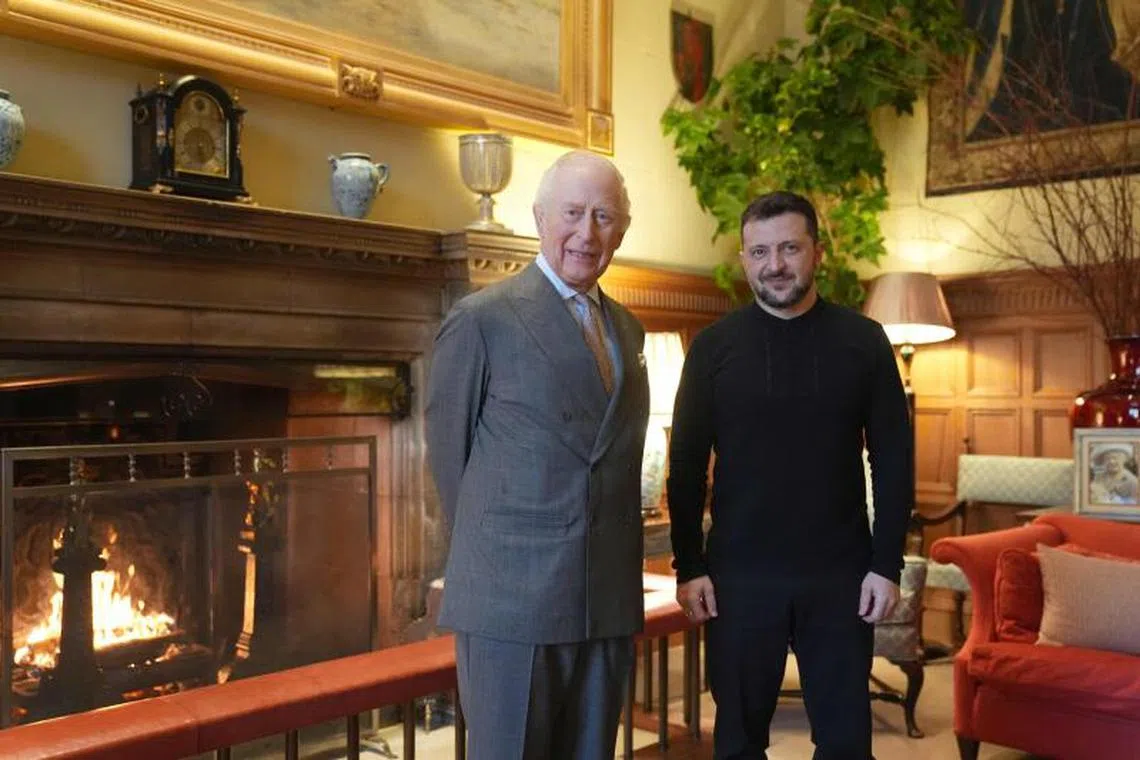European ‘coalition of the willing’ to draw up Ukraine peace plan: UK’s Starmer
Sign up now: Get ST's newsletters delivered to your inbox

British PM Keir Starmer (centre) and other European leaders agree they must spend more on defence.
PHOTO: EPA-EFE
Follow topic:
LONDON - British Prime Minister Keir Starmer said on March 2 that European leaders had agreed to draw up a Ukraine peace plan to take to the United States, a vital step for Washington to be able to offer security guarantees Kyiv says are vital to deter Russia.
At a summit in London just two days after Mr Volodymyr Zelensky clashed with US President Donald Trump
European leaders agreed they must spend more on defence to show Mr Trump the continent can protect itself, and with many nations struggling with already stretched public finances, the European Commission chief suggested the bloc could ease its rules around debt.
Mr Starmer, who welcomed a visibly shaken Mr Zelensky on March 1 with a warm hug, said Britain, Ukraine, France and some other nations would form a “coalition of the willing” and draw up a peace plan to take to Mr Trump. He did not mention which other nations, but said more countries were willing to join.
“We are at a crossroads in history today,” Mr Starmer said. “This is not a moment for more talk. It’s time to act. Time to step up and lead and to unite around a new plan for a just and enduring peace.”
After Mr Trump’s shouting match with Mr Zelensky in the Oval Office raised fears of the US pulling support for Ukraine and instead imposing a peace plan negotiated with Russia, Europe is scrambling to ensure Kyiv is not squeezed out of any talks.
To do so, several leaders said they must increase defence spending - something that could help bring Mr Trump on side to offer a US security guarantee in the event of peace.
“After a long time of underinvestment, it is now of utmost importance to step up the defence investment
“Member states need more fiscal space to do a surge in defence spending,” she said, adding Europe needed to turn “Ukraine into a steel porcupine that is indigestible for potential invaders”.
Polish Prime Minister Donald Tusk said leaders agreed Europe needed to take on more responsibility and start bearing the burden of “more spending on its defence budgets within Nato”.
He added the leaders all agreed they must keep close ties with the US.
Lacking weaponry, stocks
Lacking the weaponry and depth of ammunition stocks of the US, Europe hopes to convince Mr Trump that it can defend itself, but that Russia will only adhere to a peace deal that comes with the backing of the United States.
Talks with the US have centred on Washington providing a so-called backstop for a European peacekeeping role
But crucial to getting any agreement from Mr Trump is for European nations to increase defence spending and signal they would take part in any peacekeeping role - something Mr Starmer acknowledged was difficult to get unanimity on.
Mr Starmer and France’s President Emmanuel Macron have said they are prepared to deploy British and French troops to Ukraine to help preserve the peace in the event an agreement is signed to end the war.
Nato Secretary-General Mark Rutte pointed to promises from more European countries to “ramp up defence spending”, while insisting the United States remained committed to the transatlantic alliance.
The London meeting brought together allies from around continental Europe, including France, Germany, Denmark and Italy as well as Turkey, Nato and the European Union.
In addition to attending the security summit, Mr Zelensky also met King Charles III at his Sandringham estate in England.

Britain’s King Charles III and Ukraine’s President Volodymyr Zelensky pose for a photo in the Saloon at Sandringham House.
PHOTO: AFP
‘Uncomfortable viewing’
Mr Trump has upended US policy on the three-year-old war since he returned to the White House in January, casting doubt on its military and political support for Ukraine - and Europe - and ending the isolation of Moscow.
He had blindsided Europe by calling Mr Putin without warning and sending a delegation to Saudi Arabia for talks with Russia without including Ukraine or Europe. Mr Trump has falsely suggested that Kyiv was responsible for starting the war and on Feb 28, he criticised Mr Zelensky for not being grateful for US aid.
Mr Zelensky’s row with Trump on Feb 28 ended a week when Europe had appeared to be in a better position in its drive to encourage Mr Trump to continue to offer support to Ukraine after cordial visits to Washington by French President Emmanuel Macron and Mr Starmer.
Mr Starmer described watching the spat between Mr Zelensky and Mr Trump in the Oval Office as uncomfortable viewing, but was keen to push the conversation forward by offering himself as a go-between for Europe and the United States.
In a further show of support for the Ukrainian leader, Mr Zelensky later flew to meet King Charles at his private residence in eastern England.
In a sign of the still-fractious relations between Washington and Kyiv, White House national security adviser Mike Waltz told CNN on March 2 that the US needs a Ukrainian leader
Russian Foreign Minister Sergei Lavrov also praised Mr Trump’s “common sense” approach and accused European countries of seeking to prolong the conflict by propping up Mr Zelensky “with their bayonets in the form of peacekeeping units”.
Mr Starmer said the leaders on March 2 also agreed to work to ensure Kyiv is at the table of any peace talks and boost the country’s own defence capabilities.
“Europe must do the heavy lifting, but to support peace in our continent, and to succeed this effort must have strong US backing,” Mr Starmer told a news conference. REUTERS, AFP

